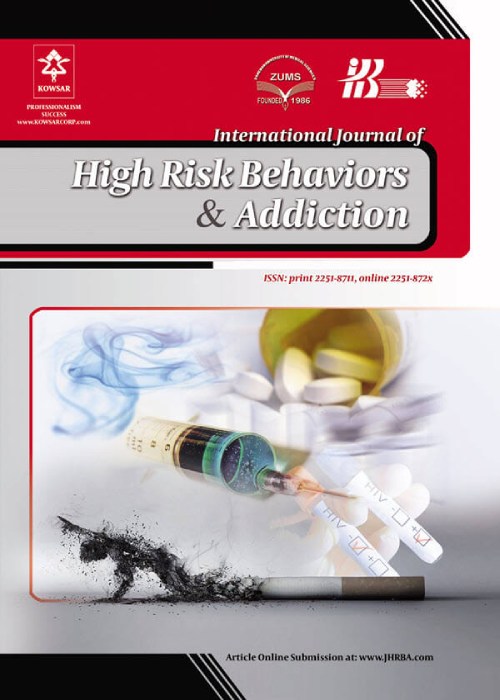Sexually Transmitted Infections Among Hospitalized Patients With Human Immunodeficiency Virus Infection and Acquired Immune Deficiency Syndrome (HIV/AIDS) in Zahedan, Southeastern Iran
Author(s):
Abstract:
Background
Studies show that nearly 40 million people are living with human immunodeficiency virus infection and acquired immune deficiency syndrome (HIV/AIDS) around the world and since the beginning of the epidemic, about 35 million have died from AIDS. Heterosexual intercourse is the most common route for transmission of HIV infection (85%). People with a sexually transmitted infection (STI), such as syphilis, genital herpes, chancroid, or bacterial vaginosis, are more likely to obtain HIV infection during sex. On the other hand, a patient with HIV can acquire other infections such as hepatitis C virus (HCV) and hepatitis B virus (HBV) and also STIs. Co-infections and co-morbidities can affect the treatment route of patients with HIV/AIDs. Sometimes, physicians should treat these infections before treating the HIV infection. Therefore, it is important to identify co-infection or comorbidity in patients with HIV/AIDS..Objectives
This study was conducted in order to understand the prevalence of HIV/AIDS/STI co-infection..Patients and
Methods
In this cross-sectional study, we evaluated all HIV/AIDS patients who were admitted to the infectious wards of Boo-Ali hospital (Southeastern Iran) between March 2000 and January 2015. All HIV/AIDS patients were studied for sexually transmitted infections (STI) such as syphilis, gonorrhea, hepatitis B virus (HBV) and genital herpes. A questionnaire including data on age, sex, job, history of vaccination against HBV, hepatitis B surface antigen (HBsAg), hepatitis B core antibody (anti-HBc), hepatitis B surface antigen (anti-HBs), HCV-Ab, venereal disease research laboratory (VDRL) test, fluorescent treponemal antibody absorption (FTA-Abs) test, and urine culture was designed. Data was analyzed by the Chi square test and P values of Results
Among the 41 patients with HIV/AIDS (11 females and 30 males; with age range of 18 to 69 years) five cases (12.1%) had a positive test (1:8 or more) for VDRL. The FTA-Abs was positive for all patients who were positive for VDRL. Gonorrhea was found in seven patients (17%) and three cases had genital herpes in clinical examinations. All patients who had positive test results for these STIs were male. Eleven patients (26.8%) had HBV infection (three females and eight males). hepatitis C virus (HCV) was found in 13 cases (31%). Eighty percent of patients were unemployed. Seventy-eight percent of patients with HIV/STI were aged between 18 and 38 years. There was a significant difference between sex and becoming infected with HIV and also STI (P Conclusions
Patients with HIV/AIDS are more likely to acquire other STIs, because the same behaviors that increase the risk of becoming HIV infected can also increase the risk of acquiring STIs. Having a sore on the skin due to an STI can make the transmission of HIV to the sex partner more likely than people who dont have such sore in their genital area..Language:
English
Published:
International Journal of High Risk Behaviors and Addiction, Volume:5 Issue: 3, Sep 2016
Page:
5
magiran.com/p1585340
دانلود و مطالعه متن این مقاله با یکی از روشهای زیر امکان پذیر است:
اشتراک شخصی
با عضویت و پرداخت آنلاین حق اشتراک یکساله به مبلغ 1,390,000ريال میتوانید 70 عنوان مطلب دانلود کنید!
اشتراک سازمانی
به کتابخانه دانشگاه یا محل کار خود پیشنهاد کنید تا اشتراک سازمانی این پایگاه را برای دسترسی نامحدود همه کاربران به متن مطالب تهیه نمایند!
توجه!
- حق عضویت دریافتی صرف حمایت از نشریات عضو و نگهداری، تکمیل و توسعه مگیران میشود.
- پرداخت حق اشتراک و دانلود مقالات اجازه بازنشر آن در سایر رسانههای چاپی و دیجیتال را به کاربر نمیدهد.
In order to view content subscription is required
Personal subscription
Subscribe magiran.com for 70 € euros via PayPal and download 70 articles during a year.
Organization subscription
Please contact us to subscribe your university or library for unlimited access!



